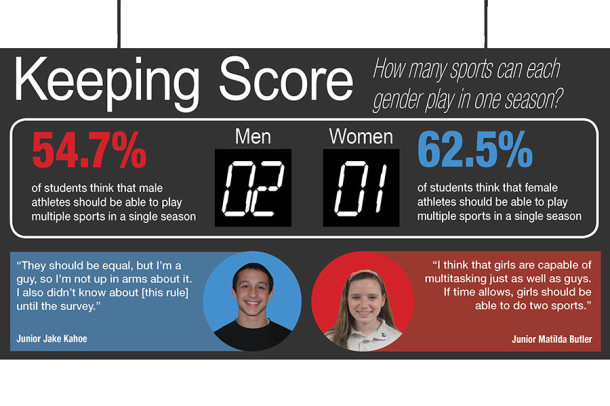Keeping Score
How many sports can each gender play in one season?
To be a fish or to be a cheetah?
Sophomore Faith Ensor walked up to the diving platform, feeling for her swim cap and goggles to make sure that they were both in place. On command, Ensor got in starting position, the same position she uses for track, and prepared to dive into the pool water.
Of course, the familiar placing of her feet was not from indoor track, but outdoor track, because girls can only participate in one sport per season according to the IAAM rules. Abiding by those rules, Ensor debated whether to be a fish or cheetah. She chose to be a fish.
The IAAM conference is for women while the MIAA is the conference for men. According to Athletic Director and swimming coach Larry Dukes different conferences run by different people bring different sets of rules. The IAAM allows only one sport per season for student athletes while the MIAA allows two sports per season.
“It all begins with the philosophies of each conference,” Dukes said.
“Rules are set up by the principals [of schools] and athletic directors,” Dukes said. To his knowledge, “there are thirty members of each conference, all being private schools,” and JC is a member of both the IAAM and MIAA.
An old MIAA rule stated that football players could be soccer players, and vice versa, because kickers were needed. According to Dukes, “girls never had a sport where it was natural for a cross over, and they never had a reason to change it.”
According to The Patriot survey of students taken on Dec. 3, 66 percent of those who completed the survey were not aware of the differences between the conferences.
According to junior Eric Johnson, colleges are looking for the people who are multi-talented and well-rounded in every aspect of life. “The IAAM should change it, since a lot of people are multiple-sport athletes,” Johnson said.
“I definitely miss track. Track will always be my go-to sport, and not being able to compete with the school team is really difficult for me [because] I love to run,” Ensor said.
She wishes that she could do both swimming and running because “they’re complimentary sports. You build up endurance in both of them. It would be really beneficial if I could do both.”
However, according to senior Will Hopkins, “I don’t think anyone should do two sports because it shows a lack of dedication.”
The disparity in the rules can be upsetting to student athletes.
Acorrding to The Patriot survey, 54.7 percent of students believe that men should be able to play two sports if they wish, and 62.5 percent believe that women should be able to play two sports if they wish.
To allow for student athletes in the IAAM conference to be given their desires, Dukes “sponsored a proposal in the IAAM to let girls participate in more than one sport in a season.”
He recommended this same proposal a few years back, but it was shot down immediately. This year, they concurred to discuss the proposal in the December meeting. According to Dukes, he still has “an uphill battle.”
Dukes said that the people who’ve been around a long time in the IAAM conference believe that allowing student athletes to play two sports a season will get to a point where it “will affect their grades.” However, he said that the league does “not think it’s right as a league to allow it.”
“Grades I can guarantee, for most girls, will not be an issue,” junior Ashley Hunter said.
Dukes also believes that girls could handle it.
According to The Patriot survey, 97 of 109 students believe that sports only negatively affect grades sometimes, rarely, or never.
“There are many girls already playing two sports at the same time. Our soccer team runs out to play lacrosse on the weekends. Our field hockey team runs off and plays lacrosse tournaments on the weekends. We have people on our cross country team that swim [with] their teams on the weekend. Kids are already managing [two sports],” Dukes said.
If the proposal were to be authorized, “teams that have been struggling to get team members may not struggle anymore,” Dukes said. Athletes would not have to choose between two sports and would be able to try sports that aren’t their primary focus.
According to Dukes, “it doesn’t affect 200 people. Only special athletes can do two sports at a high level at the same time, and it takes cooperation between the coaches. [Coaches] like [cross country and track coach] Mr. Torres and I, understand the way people can cross train and have it be very effective.”
Torres agreed with Dukes.
According to Torres, “it’s silly that guys can do two and girls can’t. I think a lot of the Athletic Directors in the IAAM are under the impression that girls can’t handle what the guys can. I can see how some kids could do too much, but as long as the coaches and athletes involved are flexible, it can work.”
Elizabeth Driver is a Sports Editor for The Patriot and jcpatriot.com.



